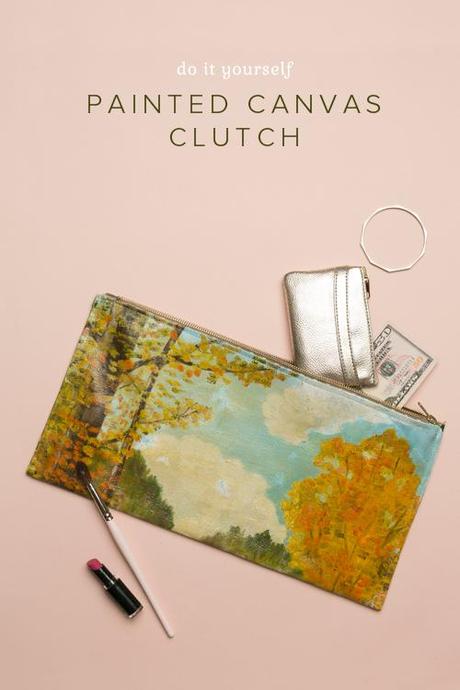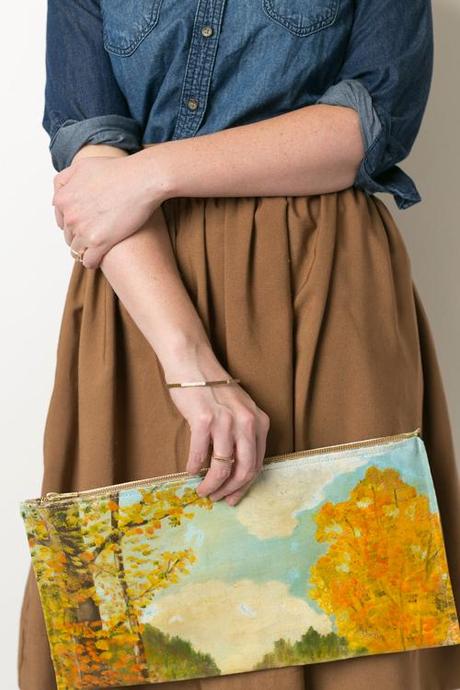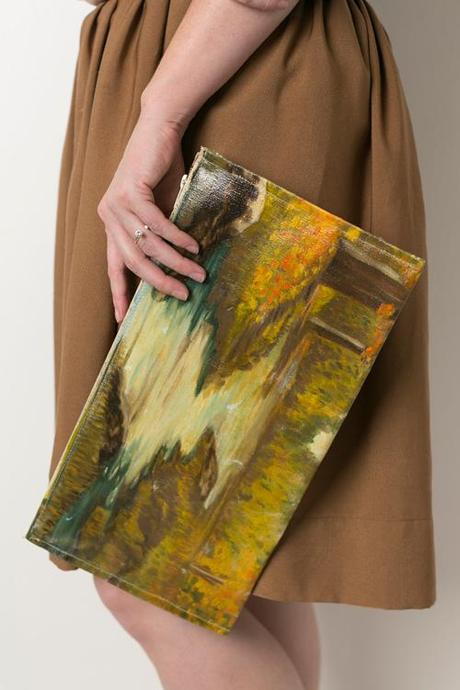 If you're looking for a fun, homemade gift to give for the holidays, Star White of Camp Makery came up with this great idea: a painting clutch! And she's showing us how to make it today.
If you're looking for a fun, homemade gift to give for the holidays, Star White of Camp Makery came up with this great idea: a painting clutch! And she's showing us how to make it today.Now, I know some of you will think "How dare you ruin someone's work of art!" but let's think more along the lines of a thrift store paintings that will probably get more visibility as a clutch than on the ground floor. I love the idea of repurposing an object and turning it into something new and usable.

Painted canvas clutch by Star White of Camp Makery
Photography by Trisha Zemp
Styling by Brittany Jepsen
Painted canvas clutch
Have you ever found a painting that you love, but there just isn't a place for it in your house? Before giving it away, think about trying out this challenging but rewarding DIY project. Turn that painting into an accessory...a clutch!
For this DIY I would recommend setting aside a few hours and some help from a friend. Every painting is different, so there will be some creative problem solving along the way. I will try to give you my best tips on this clutch conversion, but an extra set of hands is what made this project a success. A BIG thank you to my friend Maria for consultation on how to handle a vintage acrylic painting, and to my sweet mother-in-law/master seamstress for all the help on brainstorming and sewing!
Supplies:
- A painting (acrylic or a print on canvas. I would not recommend an oil painting.)
- Fabric for lining the clutch
- Craft scissors
- Fabric scissors
- Sewing maching (heavy duty)
- Denim needle for sewing machine
- Coordinating thread
- Heavy duty zipper
- Ruler
- Pen or Sharpie
- Gloss varnish (also referred to as 'medium' and found near acrylic paints at craft stores)
- Begin by looking at your painting and deciding which part(s) you would like to see as the front and back of your clutch. The painting I used was done in 1969 and had a bit of damage to the top left corner, so I decided to cut that section off and keep mainly the sky and river as a part of the purse. If your painting is attached to a frame, carefully remove it so you are working with only the canvas.
- Cut your canvas down to the desired size. I envisioned mine to be 'hot dog' style, so the end result was long and narrow. Trim around the extra pieces of canvas surrounding the painting leaving 1/4 inch remaining for the seams. This removes potential rusty spots (see top right photo) and leaves you with a pre-creased edge to work with.
- Fold painting in half to get a feel for the size/shape of the clutch. Trim as desired if the shape is too long or too wide. Now take your chosen fabric for the lining of the clutch and cut a piece the exact size of your canvas.
- With right sides facing each other, line up the fabric and the painting and sew along the top and 2 sides, creating a giant pocket of sorts. When you reach the bottom of the sides, pull back the fabric 1/4 inch and finish out the stitch (see bottom left pic).
- Trim corners at an angle. This will decrease bulkiness in the corners of the clutch when you turn it inside out.
- VERY CAREFULLY flip your clutch inside-right so the pretty parts of the painting and fabric are now on the outside. Push out each corner gently using your finger and press around the edges of the clutch to flatten it. Do not use an iron. As you can see (bottom right), manuvering an old painting this much can cause a little bit of damage. I noticed some paint flaking off as I flipped the clutch inside-right. Be gentle and only flip it 1 time if you can help it, as this will help preserve the painting.
- Fold the clutch over 'hot-dog' style and finger-press the lining at the top so it tucks behind the canvas. This is your only unfinished edge so far.
- Line up your zipper at the top of the painting, leaving a bit of space before the zipper starts. I marked with Sharpie where to place the zipper to start showing (see bottom left pic).
- Carefully begin sewing the zipper to the top part of the painting. Since you are sewing through paint, canvas, fabric, and a zipper, I reccomend a larger standard sewing machine to complete this task, as well as inserting a thick denim zipper to tackle the job. Sew until you've reached nearly the end, again leaving about 1/3 inch before the end of the top. This leaves space to tuck in the zipper later and to sew along the sides of the clutch.
- Repeat this process on the opposide side to attatch the other side of the zipper. Remember to leave 1/3 of an inch on each end of the zipper so you have room to sew up the sides. If your zipper is long like mine, you will end up tuckin the zipper inside the clutch.
- Now sew along the 2 sides of the clutch, creating an enclosed space. This was the most challenging part of the entire project for me. With the help of my mother-in-law, we hand cranked the sewing machine through the thickest parts and had to pull and push the painting/fabric on either side of the needle to get it through the machine. Take your time on this part, as it will be your thickest layer to sew through.
I'm SO proud of this DIY because it took a team effort, and the result was such a fun and funky piece that will last forever!


